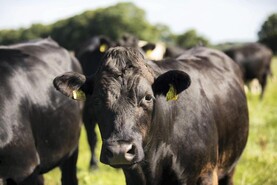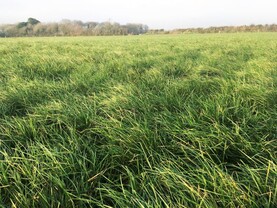Resistance found to ivermectin on 100% of trial farms
Dr Orla Keane, Teagasc, outlined the findings of recent work into the level of anthelmintic resistance in beef cattle in Ireland.
“Anthelmintic resistance is the ability of a worm to survive a dose that should kill it,” she explained. “Worms tend to like warm, wet weather. With the dry conditions we had this year, worm levels are quite low in general.” There are two main types of gut worm – ostertagia osteragi and cooperia oncophera.
“The osteragia worms,” said Dr Keane, “have the ability to enter a period of hibernation for the winter and a re-emerge in the spring once again. This is why it is key to treat for worms at housing.” Speaking about the trials, Dr Keane explained they were carried out on dairy calf-to-beef farms: “Suckler calves generally have low levels of worms until after they are weaned.”
Only dose animals when needed, don’t use combination products when you are only targeting one species of worm and be sure to only use the recommended dose
Results showed 100% ivermectin resistance, 75% moxidectin resistance, 71% benzimidazole resistance and 25% levamisole resistance. On the sustainable use of anthelmintics, Dr Keane said grazing management can play a big role.
But the most important factor in limiting anthelmintic resistance is responsible use of products. “Only dose animals when needed,” said Dr Keane, “and don’t use combination products when you are only targeting one species of worm and be sure to only use the recommended dose.”
Finally, to identify when it is necessary to treat for gut worms, Dr Keane said “faecal egg-count is useful but many farmers will just choose to pay for dosing rather than for a faecal sample. Monitoring animals performance is probably the most important – if animals are performing OK, then they don’t need to be treated.”
Future DNA testing as part of new Dairy beef index
“The industry will at some stage in the near future have to move to DNA testing of calves to ensure accuracy around a dairy beef index,” said Prof Donagh Berry.
His comments come ahead of a planned rollout of the dairy beef index ahead of spring 2019 breeding. It is well known that dairy farmers rate gestation length and ease of calving as most important when selecting sires.
The problem is that these sires are not producing cattle with sufficient beef merit. Many of the AI beef bulls used in the dairy herd last year were negative for kg of carcase which means that animals will kill out much lighter and struggle to meet minimum weight requirements.
Some beef farmers are already starting to see this with heifer calves purchased in 2016/2017 as these animals finish at very light weights. It is a huge issue for the industry and it needs prompt attention.
Many farmers who have gone down this road are questioning the profitability of the dairy beef system, with the current genetics that are being used on the dairy herd.
Berry said the objective during development of this new dairy beef index has been to identify bulls that, on average, produce efficient progeny with good carcase credentials born with minimal fuss to the dam and dairy farmer. He said the intensifying interest among modern-day consumers in the origin of their food necessitates breeding programmes to take into account issues such as temperament and polledness.
Access to low-cost DNA screening tools provides a strategy to verify parentage of each calf, verify breed composition, and generate more accurate estimates of genetic merit for that calf. Such a technique should aid in identifying animals, at a young age, most suitable for different production systems and markets.
Beef Conference in quotes
“Best practice when faecal sampling is to take a pooled sample from 10 animals. The sample must be sent fresh to avoid eggs hatching before testing” – Dr Orla Keane
“It is very difficult to control dosage rates with pour-ons. Some of the pour-on is taken in through the skin but the majority is taken in by the animal licking at themselves. This is obviously a very hard thing to control” – Dr Orla Keane
“If you ever wanted evidence that climate change is happening, 2018 was it. These freak weather events are probably going to get more common and more severe” – Professor Gerry Boyle
“We have to recognise there is massive interdependence between beef and dairy. Suckler farming will remain as a speciality business but there are opportunities for beef farmers to rear heifers or dairy calf to beef systems”
– Professor Gerry Boyle
“If we don’t vaccinate the adult herd for IBR we will not be successful in eradicating IBR from the national beef herd. Vaccinating young stock is not enough”
– Dr Maria Guelbenzo, AHI
“Fertiliser went out as normal in February and 30 cows went out but we had to take them back in again, we lost 14 calves and three cows with pneumonia as a result. The main cause was poor ventilation programme and an inadequate vaccination programme. 2018 won’t be forgotten on our farm” – James Flaherty, beef farmer, Co Kerry
“We are quite clearly seeing a reduction in the quality of cattle from the dairy herd in terms of carcase weight and conformation. The dairy beef index aims to reverse this trend” – Prof Donagh Berry
“If I was to bet my house on it, age at slaughter will become the next pivotal trait in the beef industry” – Prof Donagh Berry
“We need to be seven to 10 years ahead of the game in terms of national breeding objectives and I believe that meat eating quality will be the next inclusion in our genetic indexes. We will have the largest genotypic database linked to meat tenderness in the world and we need to look at how this can be incorporated”
– Professor Donagh Berry
Resistance found to ivermectin on 100% of trial farms
Dr Orla Keane, Teagasc, outlined the findings of recent work into the level of anthelmintic resistance in beef cattle in Ireland.
“Anthelmintic resistance is the ability of a worm to survive a dose that should kill it,” she explained. “Worms tend to like warm, wet weather. With the dry conditions we had this year, worm levels are quite low in general.” There are two main types of gut worm – ostertagia osteragi and cooperia oncophera.
“The osteragia worms,” said Dr Keane, “have the ability to enter a period of hibernation for the winter and a re-emerge in the spring once again. This is why it is key to treat for worms at housing.” Speaking about the trials, Dr Keane explained they were carried out on dairy calf-to-beef farms: “Suckler calves generally have low levels of worms until after they are weaned.”
Only dose animals when needed, don’t use combination products when you are only targeting one species of worm and be sure to only use the recommended dose
Results showed 100% ivermectin resistance, 75% moxidectin resistance, 71% benzimidazole resistance and 25% levamisole resistance. On the sustainable use of anthelmintics, Dr Keane said grazing management can play a big role.
But the most important factor in limiting anthelmintic resistance is responsible use of products. “Only dose animals when needed,” said Dr Keane, “and don’t use combination products when you are only targeting one species of worm and be sure to only use the recommended dose.”
Finally, to identify when it is necessary to treat for gut worms, Dr Keane said “faecal egg-count is useful but many farmers will just choose to pay for dosing rather than for a faecal sample. Monitoring animals performance is probably the most important – if animals are performing OK, then they don’t need to be treated.”
Future DNA testing as part of new Dairy beef index
“The industry will at some stage in the near future have to move to DNA testing of calves to ensure accuracy around a dairy beef index,” said Prof Donagh Berry.
His comments come ahead of a planned rollout of the dairy beef index ahead of spring 2019 breeding. It is well known that dairy farmers rate gestation length and ease of calving as most important when selecting sires.
The problem is that these sires are not producing cattle with sufficient beef merit. Many of the AI beef bulls used in the dairy herd last year were negative for kg of carcase which means that animals will kill out much lighter and struggle to meet minimum weight requirements.
Some beef farmers are already starting to see this with heifer calves purchased in 2016/2017 as these animals finish at very light weights. It is a huge issue for the industry and it needs prompt attention.
Many farmers who have gone down this road are questioning the profitability of the dairy beef system, with the current genetics that are being used on the dairy herd.
Berry said the objective during development of this new dairy beef index has been to identify bulls that, on average, produce efficient progeny with good carcase credentials born with minimal fuss to the dam and dairy farmer. He said the intensifying interest among modern-day consumers in the origin of their food necessitates breeding programmes to take into account issues such as temperament and polledness.
Access to low-cost DNA screening tools provides a strategy to verify parentage of each calf, verify breed composition, and generate more accurate estimates of genetic merit for that calf. Such a technique should aid in identifying animals, at a young age, most suitable for different production systems and markets.
Beef Conference in quotes
“Best practice when faecal sampling is to take a pooled sample from 10 animals. The sample must be sent fresh to avoid eggs hatching before testing” – Dr Orla Keane
“It is very difficult to control dosage rates with pour-ons. Some of the pour-on is taken in through the skin but the majority is taken in by the animal licking at themselves. This is obviously a very hard thing to control” – Dr Orla Keane
“If you ever wanted evidence that climate change is happening, 2018 was it. These freak weather events are probably going to get more common and more severe” – Professor Gerry Boyle
“We have to recognise there is massive interdependence between beef and dairy. Suckler farming will remain as a speciality business but there are opportunities for beef farmers to rear heifers or dairy calf to beef systems”
– Professor Gerry Boyle
“If we don’t vaccinate the adult herd for IBR we will not be successful in eradicating IBR from the national beef herd. Vaccinating young stock is not enough”
– Dr Maria Guelbenzo, AHI
“Fertiliser went out as normal in February and 30 cows went out but we had to take them back in again, we lost 14 calves and three cows with pneumonia as a result. The main cause was poor ventilation programme and an inadequate vaccination programme. 2018 won’t be forgotten on our farm” – James Flaherty, beef farmer, Co Kerry
“We are quite clearly seeing a reduction in the quality of cattle from the dairy herd in terms of carcase weight and conformation. The dairy beef index aims to reverse this trend” – Prof Donagh Berry
“If I was to bet my house on it, age at slaughter will become the next pivotal trait in the beef industry” – Prof Donagh Berry
“We need to be seven to 10 years ahead of the game in terms of national breeding objectives and I believe that meat eating quality will be the next inclusion in our genetic indexes. We will have the largest genotypic database linked to meat tenderness in the world and we need to look at how this can be incorporated”
– Professor Donagh Berry






 This is a subscriber-only article
This is a subscriber-only article










SHARING OPTIONS: